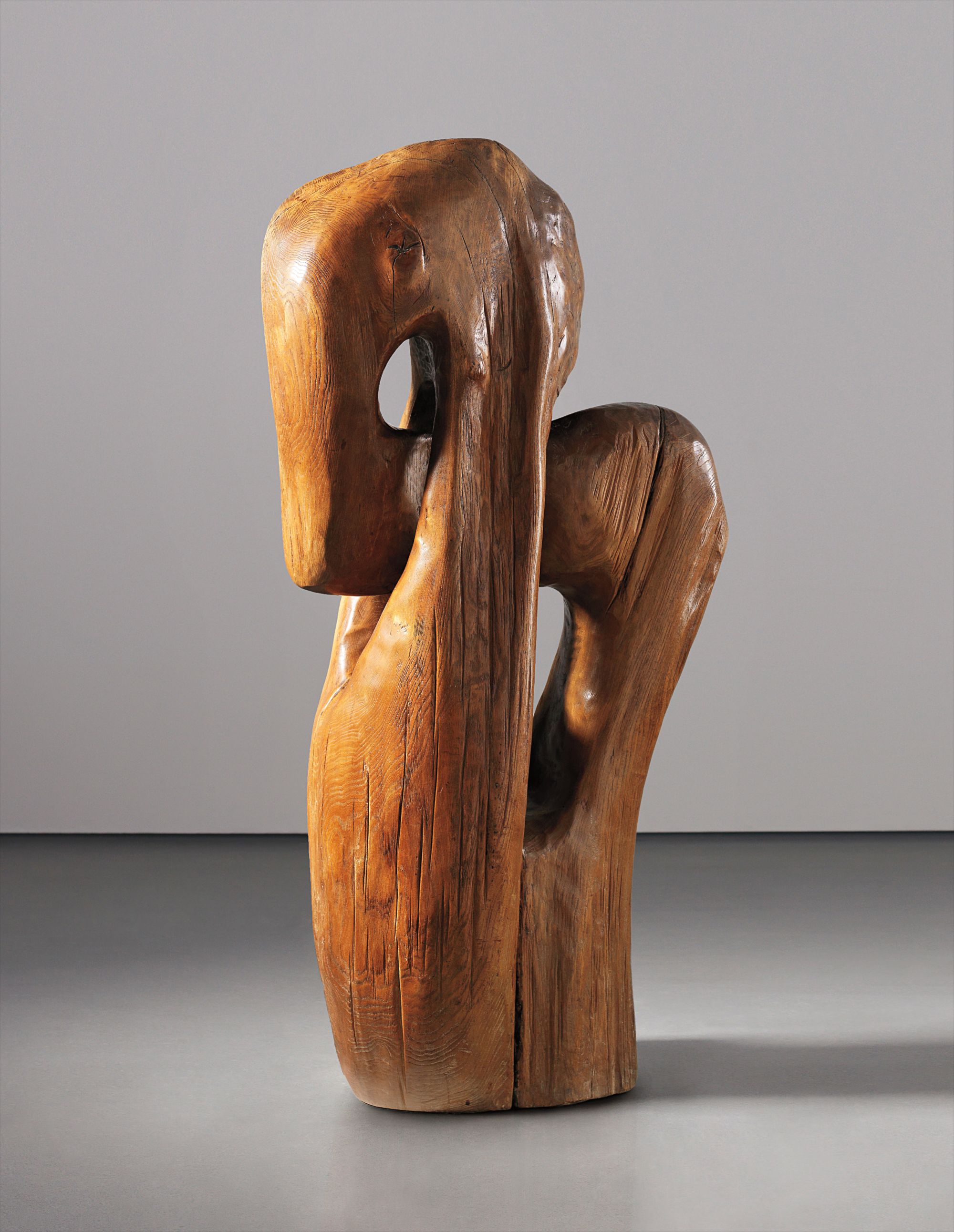

62
Alexandre Noll
Important and large sculpture
1953
Elm.
107.4 cm (42 1/4 in.) high
Incised with artist's signature and dated ANoll 1953.
Full-Cataloguing
Noll discovered woodcarving during the First World War as an air force conscript camped in the Dardanelles. Also a writer and musician, he wrote for the Cahiers des Contadors and reportedly supplied the musical accompaniment to Isadora Duncan on a few occasions. Following the war Noll began his career as an artist in the commercial environment of department stores, and quickly attracted attention from established designers of the period such as Paul Poiret, who commissioned him to design decorative objects and household goods.
For the next half century, he never renounced his belief in the sacredness of wood, whether mahogany, sycamore, teak, elm, or ebony. He mastered every block of rough timber by cutting, carving, chiseling, and sanding. The catalogue of verbs is intentional, for Noll’s engagement with wood was an expression of action between subject and object. Wood, like verbs, can be inflected: he changed the shape of every base block—gave it new function as furniture and sculpture—without modifying its nature. In this sense his every engagement with wood was a respectful confrontation resolved through final agreement. He once said, ‘Even felled, cut, the tree continues to live…’
Noll’s mid-century sculptures are in parallel to those by contemporaries like Henry Moore, Jean Arp, and Barbara Hepworth, who also produced abstract forms with strong anthropomorphic undertones. Formal analysis of these artists can shed light on Noll’s work. For example, in the essay ‘Fitting Together’, in the 1968 exhibition catalogue for Henry Moore, published by the Arts Council, David Sylvester compares Moore to Jean Arp on the basis of their shared practice of piecing together limb-like shapes. Noll’s work suggests the same morphing of elements, but the brilliance of his efforts are in the fact that his sculptures were carved from single blocks of wood. Noll was informed as much by the material’s inherent qualities as his own creative impulse.
It is if as Michelangelo once said, ‘every block of stone has a statue inside it and it is the task of the sculptor to discover it’, Noll also saw it as his mission to unlock the sculpture in a block of wood. Tracing this connection between artist and material, Olivier Jean-Elie and Pierre Passebon write that ‘it was the sculpture’s nature that acted as model, and the decision to sculpt derived directly from the choice of a particular wood’. (Alexandre Noll, Paris, 1999, p. 70) Ultimately, Noll’s sculptures provoke a response based as much on awe of human skill as nature’s innate artistry.
For the next half century, he never renounced his belief in the sacredness of wood, whether mahogany, sycamore, teak, elm, or ebony. He mastered every block of rough timber by cutting, carving, chiseling, and sanding. The catalogue of verbs is intentional, for Noll’s engagement with wood was an expression of action between subject and object. Wood, like verbs, can be inflected: he changed the shape of every base block—gave it new function as furniture and sculpture—without modifying its nature. In this sense his every engagement with wood was a respectful confrontation resolved through final agreement. He once said, ‘Even felled, cut, the tree continues to live…’
Noll’s mid-century sculptures are in parallel to those by contemporaries like Henry Moore, Jean Arp, and Barbara Hepworth, who also produced abstract forms with strong anthropomorphic undertones. Formal analysis of these artists can shed light on Noll’s work. For example, in the essay ‘Fitting Together’, in the 1968 exhibition catalogue for Henry Moore, published by the Arts Council, David Sylvester compares Moore to Jean Arp on the basis of their shared practice of piecing together limb-like shapes. Noll’s work suggests the same morphing of elements, but the brilliance of his efforts are in the fact that his sculptures were carved from single blocks of wood. Noll was informed as much by the material’s inherent qualities as his own creative impulse.
It is if as Michelangelo once said, ‘every block of stone has a statue inside it and it is the task of the sculptor to discover it’, Noll also saw it as his mission to unlock the sculpture in a block of wood. Tracing this connection between artist and material, Olivier Jean-Elie and Pierre Passebon write that ‘it was the sculpture’s nature that acted as model, and the decision to sculpt derived directly from the choice of a particular wood’. (Alexandre Noll, Paris, 1999, p. 70) Ultimately, Noll’s sculptures provoke a response based as much on awe of human skill as nature’s innate artistry.